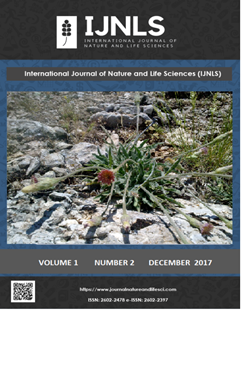The Importance of Endangered Anatolian (Oriental) Sweetgum Forests for the Bird Species
The Importance of Endangered Anatolian (Oriental) Sweetgum Forests for the Bird Species
Anatolian (oriental) sweetgum forests, bird community, bird diversity, conservation of birds and forests habitat fragmentation, Liquidambar orientalis,
___
- Alan, M., Kaya, Z. (2003). Oriental Sweet Gum (Liquidambar orientalis Mill.). EUFORGEN Technical Guidelines.
- BirdLife International, (2017). Streptopelia turtur (Amended version of 2017 assessment). The IUCN Red List of Threatened Species. https://dx.doi.org/10.2305/IUCN.UK.2019-3.RLTS.T22690419A154373407.en downloaded on 13 February 2019.
- Boyla, K. A., Sinav, L., Dizdaroğlu D. E. (2019). Türkiye Üreyen Kuş Atlası (Breeding Bird Atlas of Turkey). WWF-Türkiye, Doğal Hayatı Koruma Vakfı, İstanbul.
- Grigory, D., Gibbons, D. W., Donald, P. F. (2004). Bird Census and Survey Techniques. William J. Sutherland, Ian Newton, and Rhys Green (Eds.), In: Bird Ecology and Conservation: A Handbook of Techniques. Oxford: Oxford University Press.
- Kavak, S., Wilson, B. (2018). Liquidambar orientalis. The IUCN Red List of Threatened Species 2018. http://dx.doi.org/10.2305/IUCN.UK.20181.RLTS.T62556A42326468.en.Downloaded on 10 February 2019.
- Krebs, C. J. (1989). Ecological Methodology. New York: Harper and Row Publishers Inc.
- Laurance, W. F. (2008). Theory meets reality: how habitat fragmentation research has transcended island biogeographic theory. Biological Conservation, 141 (7) 1731-1744.
- Özkil, A., Ürker, O., Zeydanlı, U. (2017). Art in Sweetgum Forest. Nature Conservation Centre. Ankara: Dumat Ofset.
- Ürker, O., Yalçın, S. (2011). Köyceğiz’de Biterse Dünya‘da da Biter! Sığla Ormanı. TÜBİTAK Bilim ve Teknik Dergisi, Ankara, Turkey.
- Ürker, O., Çobanoğlu, N. (2017). Çevre Etiği Bağlamında Anadolu Sığla Ormanları. LAP - Lambert Academic Publishing, Germany.
- Ürker, O., İlemin, Y. (2019). A pioneer study on the wildlife properties of anatolian sweetgum forests, a case assesment on mammalian diversity in terms of ecosystem integrity. Fresenius Environmental Bulletin, 28 (7), 5474-5480.
- Ürker, O., Lise, Y. (2018). Anadolu sığla ormanları örneği üzerinden doğa korumada yeni bir kavram olan hassas orman ekosistemlerinin incelenmesi. Anatolian Journal of Forest Research, 4 (1), 1-10.
- Wilcove, D. S., McClellan, C. H., Dobson, A. P. (1986). Habitat Fragmentation in the Temperate Zone. In; M. E. Soule (Ed.), Conservation biology: the science of scarcity and diversity. Sinauer Associates, Sunderland, MA.
- ISSN: 2602-2478
- Yayın Aralığı: Yılda 2 Sayı
- Başlangıç: 2017
- Yayıncı: Uğur ÇAKILCIOĞLU
Raju ASİRVATHAM, Joshila AKHİL
Abolfazl JAFARI-SALES, Behboud JAFARİ, Homeira KHANESHPOUR, Mehrdad PASHAZADEH
Ethnobotanical Features of Ziziphora L. (Lamiaceae) Taxa in Turkey
Grace M. GOMONET, Ulysses CAGASAN
The Importance of Endangered Anatolian (Oriental) Sweetgum Forests for the Bird Species
